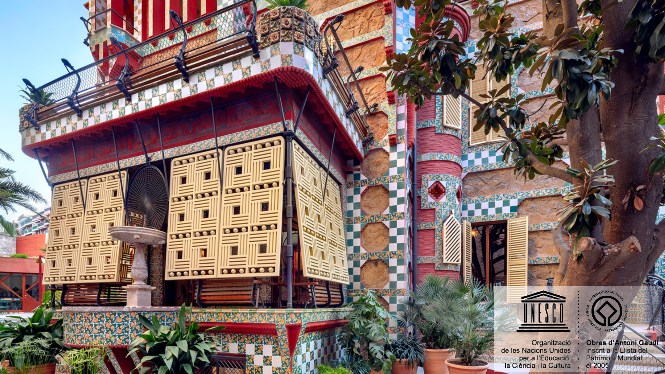Barcelona offers a wide range of interesting options all year round and opens its doors to everyone. Make the most of the sunshine to go for a stroll and take a dip in the sea on one of the city’s accessible beaches. Experience Gaudí’s nature with your hands, add a sign-language tour or an audiodescribed show to your plans… Do you need any more ideas? You’ll find them with the SEARCH FACILITY or on the SUMMARY for accessible places of interest!

Barcelona's Casa Vicens (1883-1885), declared a World Heritage Site by UNESCO in 2005, a unique oasis of calm with an Oriental and Moorish flavour, stands in the peaceful neighbourhood of Gràcia. The building is covered with spectacular green and white tiles.
It was built by a young Gaudí as a summer home commissioned by Manel Vicens y Montaner (1836-1895), a stock market dealer and broker. It is the first of Gaudí's works in Barcelona in which he was able to display the full range of his talents. He created an innovative and original project that broke completely with the style of anything else built in Catalonia up to that point. Casa Vicens is one of the first examples of an aesthetic renewal in art and architecture that took place in Europe at the end of the 19th century. It marks the beginning of Gaudí's artistic career and is considered to be one of the first masterpieces of Modernism.
The most important source of inspiration in all Gaudí's work is the world of nature, and Casa Vicens is one of the first examples, given that it represents and incorporates a variety of natural elements into the overall design.
Particularly striking is the cast iron gate at the entrance to the estate, which features representations of palm tree leaves and then the carnations that Gaudí adapts as an ornamental feature for the ceramic tiles of the facade.
This reference to natural elements is not only present on the outside of the house but also, by integrating different decorative arts - ironwork, painting, ceramics, carpentry, mural decoration, etc. - Gaudí succeeds in having nature penetrate the inside of the house, thereby creating continuity between the exterior and interior space.
If you look beyond the decoration you'll see the historicist Mudejar style as well as the forms which are Indian and Japanese in inspiration. Gaudí paid particular attention to the corners of the building, which were ridged in order to avoid the austere appearance of classical architecture. This orientalised exoticism was greeted with enthusiasm by the elite classes at the time in Barcelona. This is why it should come as no surprise that Gaudí's first building gained a much more enthusiastic reception than his later landmarks buildings, such as " La Pedrera".
Opened as a house museum in 2017, Casa Vicens proposes a rigorous and attractive visit for all audiences, which includes a permanent exhibition and a tour of all Gaudí's original rooms, carefully preserved and restored today.